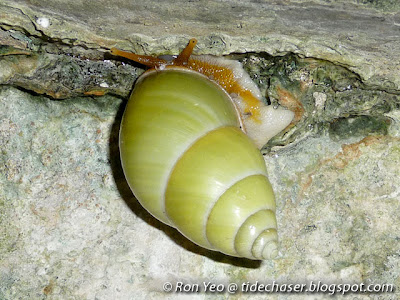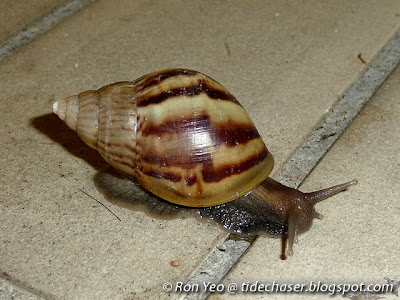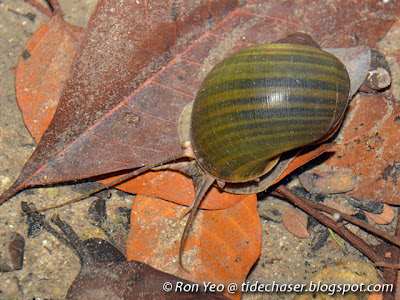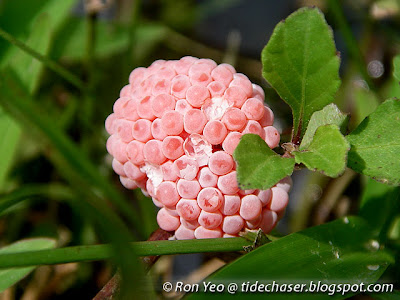A gastropod (phylum Mollusca, class Gastropoda) is a soft-bodied animal, many of which have a shell. "Gastropoda" means “stomach-foot", as gastropods often appear as if they are crawling on their stomach, which is actually their foot. They usually have one to two pairs of tentacles, and most have a radula, which is a rasping tongue-like structure for feeding.
Gastropods can be snails or slugs - snails have a single coiled shell that is usually large enough for the animal to retract into, while slugs either have a much reduced shell, an internal shell, or no shells at all. Snails and slugs are not two different genetically distinct groups though, and a particular slug may be more closely related to a snail rather than another slug.
I have already covered marine snails and slugs in earlier blog entries, and hence I will devote this entry to the few terrestrial and freshwater gastropods that I have photographed. There are certainly a lot more that I did not manage to photographed. Hopefully in future, I can add more snails to this page, and thanks to Siong Kiat for helping with the identification!

The Green Tree Snail (Amphidromus atricallosus) is possibly my favourite land snail in Singapore! This native snail has a pretty light green shell, and as the name implies, it is usually found on trees. Sometimes, we can find them on man-made structures in mature forests as well. The green colour allows the snail to blend in nicely with the leaves, and they can be very hard to spot in the foliage. The shell can grow to about 5cm tall.

The Brown Tree Snail (Amphidromus inversus) is very rare in Singapore, and some scientists suspect that it is probably introduced as it cannot be found in our mature forests, but is only confined to an area which used to be a plantation. They look very similar to the introduced African snails, but can be differentiated by the thickened and expanded outer lip. It can grow to almost 5cm tall.

The African Snail (Achatina fulica) is an introduced species, being native to Africa. The shell is brown with darker bands. It is often found in gardens, parks and other disturbed habitats, but rarely seen in forests. It lacks the thickened outer lips seen in the previous species. Young snails prefer succulent plants and are very problematic agricultural pests. Adult snails appear to prefer rotting plant matter. It can grow up to 7cm tall.

Subulina octona is also an introduced species, and the shell grows to more than 1cm long. It is usually found under flower pots, among leaf litter and low vegetation. The shell is light yellow and slightly glossy.

The Humphrey's Land Snail (Hemiplecta humphreysiana) is one of the bigger native snails here, with the shell getting to about 5cm wide. This common snail is usually found in the forest. A dark spiral line can be seen at the edge of the whorls. This snail was first discovered and brought to science with specimens from Singapore.

The dark spiral line can be easily seen on the side of the body whorl. The underside of the snail has numerous fine radiating lines.

The Luminescent Land Snail (Quantula striata) is the only known land snail capable of bioluminescence (glowing through biological processes), though it is more readily seen in the eggs and juveniles but hardly seen in adults. In the photo, it may resemble the previous species, but it is actually much smaller and the shell does not get bigger than 3cm. It can commonly be seen in forest and parks, and the colour may vary from beige to reddish brown.

The underside tends to be smooth and glossy, and numerous fine lines can be seen.

Geotrochus lychnia is a seldom seen forest species, and is usually found in leaf litter or on decaying logs. They have a glossy, dark brown shell, and the body is black (see the eye stalk above). The shell is quite small, about 1cm wide.

Cyclophorus perdix aquila, unlike most of the other native land snails in Singapore, has an operculum. And while most other land snails are hermaphrodites with both male and female reproductive parts, this species has separate sexes. The above photo features a juvenile. Adult snails will have flaring and thickened lips. It has eyes located at the base of the tentacles. The shell can grow to more than 4cm wide.

Sarika resplendens, also a native snail, has a thin, glossy and almost transparent shell. It has a very low spire, and the sides of the shell appear rounded. It exudes yellow slime when handled. There is a thin and fleshy, tentacle-like extension, often seen lying over the shell. The shell can grow to more than 1.5cm wide.

The Asian Tramp Snail (Bradybaena similaris) is an introduced species, and can be found both in the forest and urban areas. The colour of the shell ranges from a light yellowish brown to dark brown. There is usually a pair of dark stripes on the body, one on each side of the animal. It is a common agricultural pest, and is widely spread due largely to the plant trade. The shell can grow to about 1.5cm wide.

The Fragile Arion Helix (Helicarion perfragilis) is common snail easily found on low vegetation. The thin and fragile shell is partly covered by the mantle of this semi-slug. The animal can grow to about 2cm long.

The Yellow-shelled Semi-slug (Parmarion martensi) is rather variable in its body colour, though the shell is usually yellowish. It is a native species, and is commonly found in gardens and parks.

This is also a Yellow-shelled Semi-slug but of a different colour variation. There is usually a pair of dark bands running down the tentacles along the sides of the animal. This semi-slug can grow to more than 5cm long. It is not known whether it is native or not.

The Tropical Leatherleaf (Laevicaulis alte) is found in both urban and forested areas. The animal is brownish, usually with darker speckles, and has a pale line on its back. It is not known whether it is native or not, though scientists think it is most likely introduced. It can grow to about 4cm long.

Checked with my malacologist friend, Siong Kiat, and he said that this is likely to be a Semperula maculata. Guess we probably need to get a specimen to confirm the identity in future. It was more than 5cm long.

The Malaysian Trumpet Snail (Melanoides tuberculata) is a native freshwater snail, and is commonly found in all kinds of water bodies. They have tower-like shells, and may have wavy lines radial ribs or lack patterns altogether. The shell can get to over 3cm tall.

The Golden Apple Snail (Pomacea canaliculata) is an introduced species, and unfortunately can now be found in many of our freshwater bodies, such as our reservoirs, its tributaries, ponds and canals. It competes with our native apple snail, to the extent that the latter is now rarely seen. It has been introduced to various parts of the worked via the aquarium trade, and also via aquaculture since it is edible. The shell exterior is marked with spiral bands of darker and lighter tones. The shell can grow to about 6cm wide.

The eggs of the Golden Apple Snail are pink in colour, unlike our native apple snail which has white eggs.

Taia polyzonata is yet another introduced species, and can be found among rocks and on mud in many reservoirs. They can be recognised by their widely spaced and raised spiral cords. The shell can get to about 2cm high.
Reference
Gastropods can be snails or slugs - snails have a single coiled shell that is usually large enough for the animal to retract into, while slugs either have a much reduced shell, an internal shell, or no shells at all. Snails and slugs are not two different genetically distinct groups though, and a particular slug may be more closely related to a snail rather than another slug.
I have already covered marine snails and slugs in earlier blog entries, and hence I will devote this entry to the few terrestrial and freshwater gastropods that I have photographed. There are certainly a lot more that I did not manage to photographed. Hopefully in future, I can add more snails to this page, and thanks to Siong Kiat for helping with the identification!

The Green Tree Snail (Amphidromus atricallosus) is possibly my favourite land snail in Singapore! This native snail has a pretty light green shell, and as the name implies, it is usually found on trees. Sometimes, we can find them on man-made structures in mature forests as well. The green colour allows the snail to blend in nicely with the leaves, and they can be very hard to spot in the foliage. The shell can grow to about 5cm tall.

The Brown Tree Snail (Amphidromus inversus) is very rare in Singapore, and some scientists suspect that it is probably introduced as it cannot be found in our mature forests, but is only confined to an area which used to be a plantation. They look very similar to the introduced African snails, but can be differentiated by the thickened and expanded outer lip. It can grow to almost 5cm tall.

The African Snail (Achatina fulica) is an introduced species, being native to Africa. The shell is brown with darker bands. It is often found in gardens, parks and other disturbed habitats, but rarely seen in forests. It lacks the thickened outer lips seen in the previous species. Young snails prefer succulent plants and are very problematic agricultural pests. Adult snails appear to prefer rotting plant matter. It can grow up to 7cm tall.

Subulina octona is also an introduced species, and the shell grows to more than 1cm long. It is usually found under flower pots, among leaf litter and low vegetation. The shell is light yellow and slightly glossy.

The Humphrey's Land Snail (Hemiplecta humphreysiana) is one of the bigger native snails here, with the shell getting to about 5cm wide. This common snail is usually found in the forest. A dark spiral line can be seen at the edge of the whorls. This snail was first discovered and brought to science with specimens from Singapore.

The dark spiral line can be easily seen on the side of the body whorl. The underside of the snail has numerous fine radiating lines.

The Luminescent Land Snail (Quantula striata) is the only known land snail capable of bioluminescence (glowing through biological processes), though it is more readily seen in the eggs and juveniles but hardly seen in adults. In the photo, it may resemble the previous species, but it is actually much smaller and the shell does not get bigger than 3cm. It can commonly be seen in forest and parks, and the colour may vary from beige to reddish brown.

The underside tends to be smooth and glossy, and numerous fine lines can be seen.

Geotrochus lychnia is a seldom seen forest species, and is usually found in leaf litter or on decaying logs. They have a glossy, dark brown shell, and the body is black (see the eye stalk above). The shell is quite small, about 1cm wide.

Cyclophorus perdix aquila, unlike most of the other native land snails in Singapore, has an operculum. And while most other land snails are hermaphrodites with both male and female reproductive parts, this species has separate sexes. The above photo features a juvenile. Adult snails will have flaring and thickened lips. It has eyes located at the base of the tentacles. The shell can grow to more than 4cm wide.

Sarika resplendens, also a native snail, has a thin, glossy and almost transparent shell. It has a very low spire, and the sides of the shell appear rounded. It exudes yellow slime when handled. There is a thin and fleshy, tentacle-like extension, often seen lying over the shell. The shell can grow to more than 1.5cm wide.

The Asian Tramp Snail (Bradybaena similaris) is an introduced species, and can be found both in the forest and urban areas. The colour of the shell ranges from a light yellowish brown to dark brown. There is usually a pair of dark stripes on the body, one on each side of the animal. It is a common agricultural pest, and is widely spread due largely to the plant trade. The shell can grow to about 1.5cm wide.

The Fragile Arion Helix (Helicarion perfragilis) is common snail easily found on low vegetation. The thin and fragile shell is partly covered by the mantle of this semi-slug. The animal can grow to about 2cm long.

The Yellow-shelled Semi-slug (Parmarion martensi) is rather variable in its body colour, though the shell is usually yellowish. It is a native species, and is commonly found in gardens and parks.

This is also a Yellow-shelled Semi-slug but of a different colour variation. There is usually a pair of dark bands running down the tentacles along the sides of the animal. This semi-slug can grow to more than 5cm long. It is not known whether it is native or not.

The Tropical Leatherleaf (Laevicaulis alte) is found in both urban and forested areas. The animal is brownish, usually with darker speckles, and has a pale line on its back. It is not known whether it is native or not, though scientists think it is most likely introduced. It can grow to about 4cm long.

Checked with my malacologist friend, Siong Kiat, and he said that this is likely to be a Semperula maculata. Guess we probably need to get a specimen to confirm the identity in future. It was more than 5cm long.

The Malaysian Trumpet Snail (Melanoides tuberculata) is a native freshwater snail, and is commonly found in all kinds of water bodies. They have tower-like shells, and may have wavy lines radial ribs or lack patterns altogether. The shell can get to over 3cm tall.

The Golden Apple Snail (Pomacea canaliculata) is an introduced species, and unfortunately can now be found in many of our freshwater bodies, such as our reservoirs, its tributaries, ponds and canals. It competes with our native apple snail, to the extent that the latter is now rarely seen. It has been introduced to various parts of the worked via the aquarium trade, and also via aquaculture since it is edible. The shell exterior is marked with spiral bands of darker and lighter tones. The shell can grow to about 6cm wide.

The eggs of the Golden Apple Snail are pink in colour, unlike our native apple snail which has white eggs.

Taia polyzonata is yet another introduced species, and can be found among rocks and on mud in many reservoirs. They can be recognised by their widely spaced and raised spiral cords. The shell can get to about 2cm high.
Reference
- Tan, S. K. & H. P. M. Woo, 2010. A preliminary checklist of the molluscs of Singapore. Raffles Museum of Biodiversity Research, National University of Singapore, Singapore. 78 pp. Uploaded 02 June 2010.
- Tan, S. K., S. Y. Chan & G. R. Clements, 2012. A guide to snails and other non-marine molluscs of Singapore. Science Centre, Singapore. 176 pp.

No comments:
Post a Comment